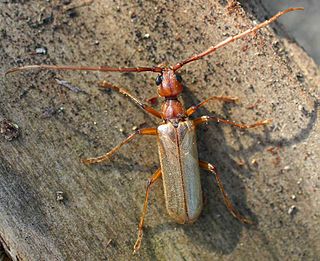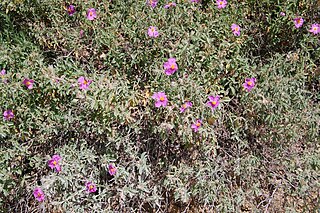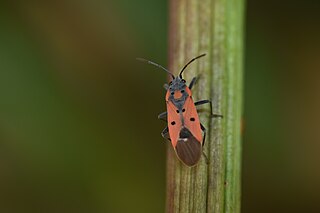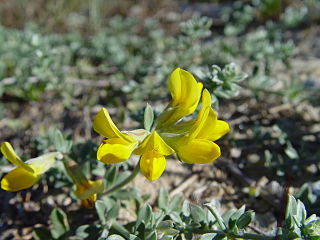Marcus Antonius Creticus, a member of the Antonius family, was a Roman politician during the Late Roman Republic. He is best known for his failed pirate-hunting career and for being the father of the general Mark Antony.

Cistus creticus is a species of shrubby plant in the family Cistaceae. Though it usually has pink flowers, of 4.5–5 cm diameter, this species is very variable. It is widely known as a decorative plant. It is frequently called "Cistus incanus".

The Asian parti-colored bat is a species of parti-coloured bat. An adult Asian parti-colored bat has a body length of 6–7 cm (2.4–2.8 in), a tail of 4.3–4.5 cm (1.7–1.8 in), and a wing length of 5 cm (2.0 in). Asian parti-colored bats are distributed across East Asia, from Taiwan through eastern China, eastern Mongolia and Russia (Siberia) to the Korean Peninsula and Japan.

The Vesperidae are a small family of beetles, normally classified within the family Cerambycidae, of heterogeneous aspect but all characterised by larval stages related to roots of herbaceous plants or trees
Quintus Caecilius Metellus Creticus was a politically active member of the Roman upper class. He was praetor in 74 BC and pontifex from 73 BC until his death. He was consul in 69 BC along with Quintus Hortensius Hortalus.
Quintus Caecilius Metellus Creticus Silanus, born Iunius Silanus was adopted by Quintus Caecilius Metellus, a descendant of the optimate Quintus Caecilius Metellus Creticus and the natural son of Marcus Junius Silanus. He was a Consul in AD 7 and governor of Syria from AD 13 to 17. Silanus was socially connected with the then-heir to the Roman principate Germanicus; his daughter at one time was betrothed to Germanicus' son Nero.
Vesperus sanzi is a species of beetle in the Vesperidae family that can be found in Portugal and western Spain.
Vesperus serranoi is a species of beetle in the Vesperidae family that is endemic to the Iberian Peninsula.

Vesperus strepens is a species of brown coloured beetle in the family Vesperidae, found in France and Italy.
Vesperus xatarti is a species of brown coloured beetle in the family Vesperidae, found in the Balearic Islands, France, and Spain.

Vesperus luridus is a species of beetle in the Vesperidae family
Vesperus jertensis is a species of brown coloured beetle in the family Vesperidae that is endemic to Spain.
Vesperus joanivivesi is a species of brown coloured beetle in the family Vesperidae that is endemic to Spain.
Vesperus conicicollis is a species of brown coloured beetle in the family Vesperidae, found in Portugal, Spain, and on the island of Sardinia.
Vesperus brevicollis is a species of brown coloured western European beetle in the family Vesperidae, found in Portugal and Spain.

Vesperus is a genus of beetles in the family Vesperidae.

Cistus × incanusL. is a hybrid between Cistus albidus and Cistus crispus. The name "Cistus incanus" has been used by other authors in a different sense, for Cistus creticus. The English name hoary rock-rose may refer to this species, among others.
Neoromicia grandidieri, known by the common names of Dobson's pipistrelle and yellow pipistrelle, is a species of vesper bat found in Africa. It was formerly in the genus Pipistrellus

Lygaeus creticus is a species of seed bug in the family Lygaeidae. It is found in areas around the Mediterranean Sea.

Lotus creticus is a species of perennial herb of the family Fabaceae found in tropical Africa. It is symbiosis competent and engages in nitrogen-fixing symbiotic interactions with species of the Ensifer genus It comprises three varieties found in the Mediterranean although there is some controversy as to whether each subgroup could be considered the same species but are classically described as being subgroups. Varieties consist of the most commonly cited silky-hairy var. creticus which is widely distributed in its western part of the coast, the non-silky var. glabrescens which has a western Mediterranean distribution; and the eastern Mediterranean var. collinus which is also not silky and can be described by long petioles and peduncles.






